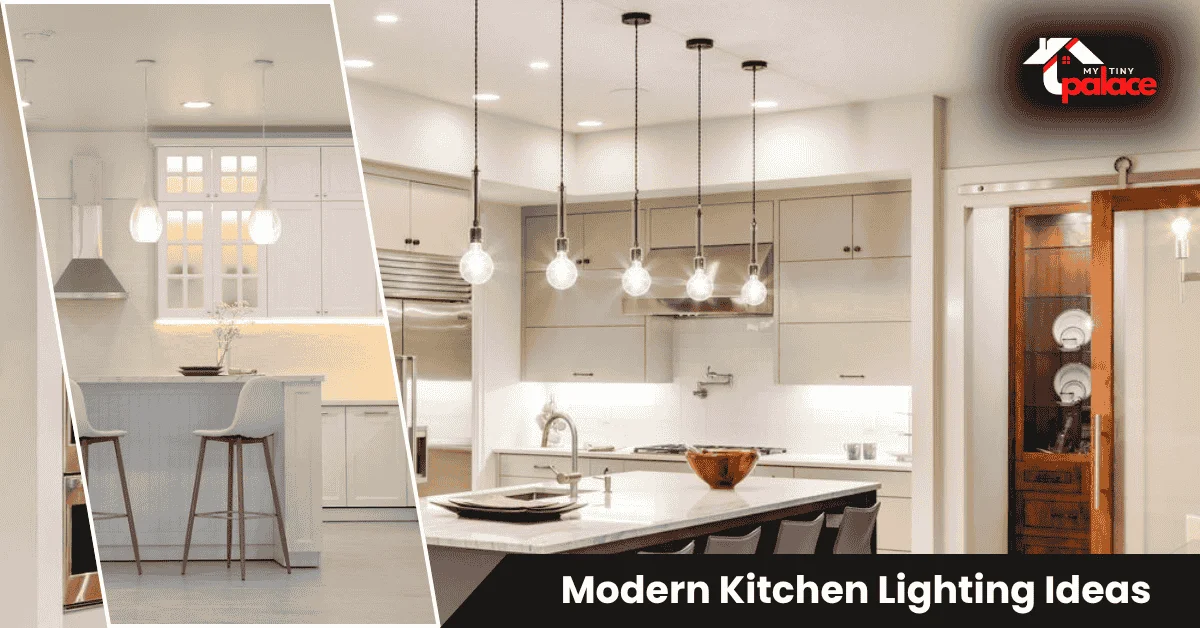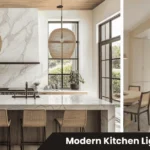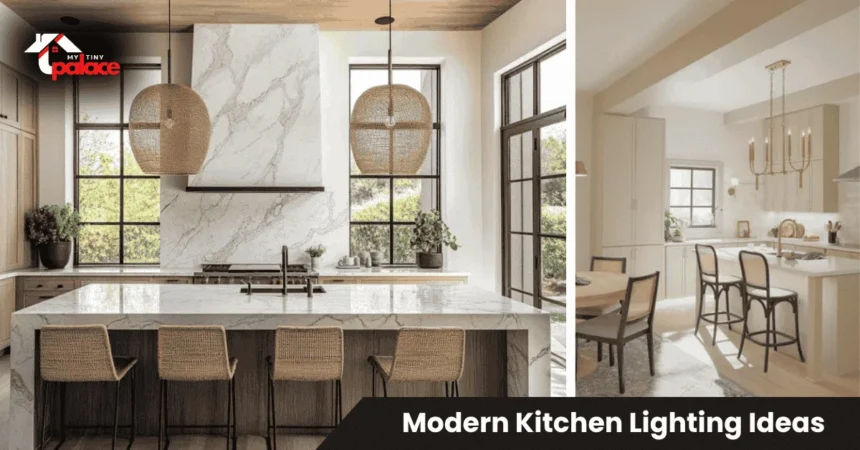Your kitchen works harder than any other room in your home. It’s where morning coffee happens, where homework gets done between dinner prep, and where friends gather during parties. But here’s something most homeowners miss: the right lighting can make all these moments better.
- Quick Overview — What You’ll Learn About Modern Kitchen Lighting
- What Are Modern Kitchen Lighting Ideas?
- Why Modern Lighting Matters in Kitchen Design
- Understanding the 3 Layers of Modern Kitchen Lighting
- Choosing the Right Fixtures for Your Kitchen Layout
- Modern Kitchen Lighting Ideas by Style
- Energy-Efficient & Smart Lighting Options
- Costs, Setup & Maintenance: What to Expect
- Mistakes to Avoid When Planning Modern Kitchen Lighting
- Bringing It All Together — Designing Light That Works for You
Good lighting doesn’t just help you see what you’re chopping. It sets the mood, makes your space feel bigger, and turns a basic kitchen into a room you actually want to spend time in. Whether you’re updating a single fixture or planning a full renovation, modern kitchen lighting ideas blend style with real-world function.
Quick Overview — What You’ll Learn About Modern Kitchen Lighting
This guide walks you through everything you need to know about lighting your kitchen the modern way. You’ll learn how to layer different light sources, pick fixtures that match your layout, and avoid the most common mistakes homeowners make. We’ll also cover smart lighting options, realistic costs, and design ideas for different kitchen styles. By the end, you’ll know exactly how to create a kitchen that looks great and works even better.
What Are Modern Kitchen Lighting Ideas?
Modern kitchen lighting ideas focus on combining clean design with practical illumination. Unlike older kitchens that relied on a single overhead fixture, today’s approach uses multiple light sources working together. Think sleek pendant lights over an island, LED strips under cabinets, and recessed lights in the ceiling.
The “modern” part isn’t just about trendy fixtures. It’s about layering three types of lighting: ambient (overall brightness), task (focused light for cooking), and accent (highlighting features you love). Modern fixtures tend to have minimal designs, use energy-efficient bulbs, and often include smart controls you can adjust from your phone.
This approach works because it gives you flexibility. You can have bright light for meal prep, then dim everything down for a relaxed dinner atmosphere. The fixtures themselves become part of your kitchen’s style, not just functional add-ons.
Why Modern Lighting Matters in Kitchen Design
Lighting affects how your kitchen feels and functions every single day. Poor lighting makes food prep harder and more dangerous. You’ll strain your eyes reading recipes, and those dark corners make the whole space feel smaller and less inviting.
Good lighting does the opposite. It makes colors pop, shows off your backsplash or countertops, and creates a welcoming atmosphere. Natural light matters too, but you can’t control when the sun sets. That’s why a solid artificial lighting plan keeps your kitchen usable and beautiful at any hour.
The right balance between different light sources also impacts your mood. Harsh overhead lights feel clinical. Too dim, and everything becomes gloomy. Modern lighting lets you adjust brightness and warmth to match what you’re doing, whether that’s cooking an elaborate dinner or having late-night snacks.
Understanding the 3 Layers of Modern Kitchen Lighting

Most people think of lighting as an on-or-off situation. But professional designers always use three distinct layers, and you should too.
Ambient lighting provides overall illumination for the entire room. This is your base layer. Recessed ceiling lights, flush-mount fixtures, or modern chandeliers all work as ambient sources. They make sure you can move around safely and see the whole space clearly.
Task lighting focuses directly on work areas. Under-cabinet LED strips light up your countertops for chopping and prep work. Pendant lights over the island give you focused brightness exactly where you need it. Track lighting can spotlight your stove area. These fixtures prevent shadows from falling on your workspace.
Accent lighting adds depth and highlights features you want to show off. LED strips inside glass cabinets make dishes glow. Small spotlights can emphasize artwork or open shelving. Toe-kick lights under cabinets create a subtle floating effect. This layer isn’t strictly necessary, but it makes the difference between a functional kitchen and a stunning one.
How to Layer Light Like a Pro
Start with your ambient layer to establish overall brightness. Add task lighting where you actually work—counters, island, stove. Then sprinkle in accent lighting to create visual interest. Use dimmers on at least your ambient and task lights so you can adjust the mood. The key is making sure no single light source has to do everything. When each layer handles its job, the whole space works better.
Choosing the Right Fixtures for Your Kitchen Layout
Your kitchen’s shape determines which fixtures work best. An island or peninsula screams for pendant lights. Hang them 30 to 36 inches above the counter surface—high enough to avoid head bumps but low enough to actually light the workspace. For a standard island, two or three pendants work better than one large fixture.
Galley kitchens need even lighting along both sides. Recessed lights down the center of the ceiling work well, spaced about 4 feet apart. Add under-cabinet strips on both walls to eliminate shadows on your counters.
L-shaped and U-shaped layouts benefit from a mix of recessed ceiling lights for ambient coverage plus targeted task lighting. Place under-cabinet lights along your counter runs, and consider a small pendant or two over any breakfast nook area.
Open-plan kitchens that flow into living spaces need lighting that transitions smoothly. Use matching or complementary fixtures to maintain visual flow. A row of modern pendants over the island can mirror similar fixtures in the dining area, creating cohesion without everything looking identical.
Track lighting works well in kitchens with vaulted ceilings or when you want flexibility. You can adjust individual heads to point exactly where you need light. Modern track systems look sleek and industrial rather than dated.
Modern Kitchen Lighting Ideas by Style
Minimalist kitchens work best with clean-lined fixtures that almost disappear. Think simple drum pendants in white or black, slim recessed lights, and hidden LED strips. The goal is lighting that provides function without visual clutter. Matte finishes beating shiny ones in this style.
Industrial spaces call for exposed bulbs, metal fixtures, and raw materials. Black metal pendants with Edison bulbs over the island create instant style. Cage lights or factory-inspired fixtures reinforce the look. Mix metals like brushed steel with black iron for depth.
Scandinavian-inspired kitchens embrace natural materials and soft lighting. Wood pendant shades, paper lanterns, or simple white fixtures work beautifully. Keep everything light and airy. Under-cabinet lighting should produce warm tones, not cold blue-white light.
Modern farmhouse blends rustic charm with contemporary clean lines. Try modern pendants with wood accents, matte black fixtures mixed with natural materials, or updated lantern-style lights. The key is avoiding anything too traditional or fussy.
Contemporary luxury goes bold with statement fixtures. Large geometric pendants, sculptural designs, or high-end metallic finishes make the lighting itself artwork. Gold, brass, and mixed-metal fixtures add glamour. Just remember that “luxury” doesn’t mean “complicated”—the best modern designs stay relatively simple in shape.
Energy-Efficient & Smart Lighting Options
LED bulbs have changed kitchen lighting completely. They use 75% less energy than traditional bulbs, last 25 times longer, and produce almost no heat. Yes, they cost more upfront, but you’ll save money within the first year through lower electric bills and replacement costs.
Color temperature matters more than most people realize. Measured in Kelvin, it determines whether your light feels warm or cool. For kitchens, aim for 3000K to 4000K. The lower end (3000K) gives you warm, cozy light similar to traditional bulbs. The higher end (4000K) provides brighter, whiter light that’s great for detailed tasks without feeling cold or clinical.
Dimmable LED lights give you control over brightness and mood. Install dimmer switches on your main fixtures so you can adjust from bright task lighting to subtle ambient glow. Not all LEDs work with all dimmers, so check compatibility before buying.
Smart lighting takes convenience further. Control brightness, color temperature, and on-off status from your phone or voice assistant. Set schedules so lights turn on before you get home or gradually brighten in the morning. Some systems even adjust color temperature throughout the day, mimicking natural light patterns. Motion sensors work great for pantries or under-cabinet lights—they turn on when you approach and shut off automatically to save energy.
Costs, Setup & Maintenance: What to Expect
| Fixture Type | Average Cost | Installation Time | Effort Level |
|---|---|---|---|
| LED Under-Cabinet Strips | $40-$150 | 1-2 hours | Easy (DIY) |
| Recessed Lights (per fixture) | $20-$100 | 2-3 hours | Medium (DIY or Pro) |
| Pendant Lights | $60-$400 each | 1-2 hours | Medium (Pro recommended) |
| Track Lighting | $100-$400 | 2-3 hours | Medium (DIY possible) |
| Smart Bulbs/Switches | $15-$80 per bulb | 15-30 minutes | Easy (DIY) |
Professional installation adds $100 to $300 per fixture, depending on complexity and your location. If you’re just swapping out existing fixtures, DIY makes sense. For new wiring, recessed light installation, or anything involving your electrical panel, hire a licensed electrician. Kitchen electrical work needs to meet code requirements, and mistakes can be dangerous.
Maintenance stays minimal with LED fixtures. You’ll replace bulbs far less often—sometimes only once every 10 to 15 years. Wipe fixtures down occasionally to prevent grease buildup, especially near the stove. Clean glass or acrylic covers so they stay transparent. Check connections annually to make sure everything stays secure and safe.
Mistakes to Avoid When Planning Modern Kitchen Lighting
Skipping dimmers is the biggest missed opportunity. They cost little but add huge flexibility. You’ll regret having only one brightness setting.
Using the wrong color temperature makes everything look off. Too warm (below 2700K), and your kitchen feels dingy. Too cool (above 5000K), and it feels like a hospital. Stick to that 3000K to 4000K range.
Installing only overhead lighting creates harsh shadows and unflattering light. You need that layered approach with task and accent lighting mixed in.
Hanging pendants at the wrong height causes problems. Too low, and tall people hit their heads. Too high, and the lights don’t actually illuminate the workspace. Measure carefully and follow the 30-to-36-inch rule above islands.
Forgetting about natural light when planning artificial lighting wastes an opportunity. Position task lighting to complement daylight, not compete with it. Watch how sunlight moves through your kitchen at different times before finalizing your plan.
Buying mismatched fixtures that don’t work together visually creates a disjointed look. Your fixtures don’t need to match exactly, but they should share similar finishes, shapes, or styles.
Bringing It All Together — Designing Light That Works for You
Modern kitchen lighting ideas give you the tools to create a space that works for your life. Start by thinking about how you actually use your kitchen. Do you cook elaborate meals that need bright task lighting? Host friends who gather around your island? Need homework space for kids?
Layer your lighting with those three types—ambient, task, and accent. Choose fixtures that match your kitchen’s style while providing the brightness you need. Invest in LEDs and dimmers for flexibility and efficiency. Don’t be afraid to mix fixture types and styles as long as they share a common thread.
Remember that lighting isn’t permanent. You can start with the basics and add more layers over time. Swap out fixtures as your style evolves. The best kitchen lighting grows with you, adapting to new needs and preferences. Measure twice, install once, and permit yourself to experiment until your kitchen truly glows.













